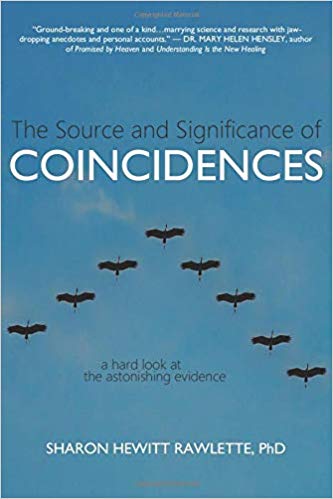The Source and Significance of Coincidences: A Hard Look at the Astonishing Evidence
By Sharon Hewittt Rawlette, Ph.D.
Self-published, 2019. 624 pp. Notes, references, index. $24.95 (paper).
ISBN-10: 1733995706. ISBN-13: 978-1733995702.
A few years ago, I was driving with my ex-wife from Durham, North Carolina, to Washington, DC, when our car (a Volvo) suddenly lost power. I was able to steer it onto the shoulder before it stopped entirely. This had never happened before and so far as I knew, the car was in no need of maintenance. I called AAA from my cell phone and was advised that we were within five minutes of a non-dealer Volvo service facility, to which I agreed to be towed. I was not aware that Volvo had such things, much less that there was one so near to us. We were close enough to be towed by AAA without charge, and the facility gave us a shuttle bus ride to a motel for the night and back in the morning. We had to pay for nothing but the night in the motel because the mechanics could find nothing wrong with the car. Although it would not start that night, in the morning it did. So we went on our way and later learned that there had been a major pile-up along our route and the place and timing were such that we very likely would have been caught up in it had we proceeded the evening before.
Sharon Hewitt Rawlette is a philosopher with a Ph.D. from New York University. Her previous book, The Feeling of Value, winner of the NYU Dean’s Outstanding Dissertation Award, rejected the dominant view in the philosophy of ethics that assessments of value were derived from external events and instead took the position that the appreciation of value is an intrinsic property of consciousness. Shortly after its publication, Rawlette decided to leave academia and a series of personal experiences led her to become interested in apparent coincidences as anomalous phenomena.
In her new book, The Source and Significance of Coincidences, Rawlette adopts a very expansive conception of coincidences as including any events that occur at or around the same time, have some sort of evident meaningful connection, yet are unrelated in a materially causal way. She is interested not only in the nature of these coincidences but in understanding what is behind them—are they arranged by God, angels, or guardian spirits; do they derive from connections made in collective unconscious; or are they produced by the experiencers themselves, with the aid of their own psi (ESP or psychokinesis)? What stopped my car, so conveniently by that service facility? Perhaps it was God or a spirit protector or perhaps it was me, unconsciously scanning into the future and around us, then bringing the car to a halt in an optimal place to keep us from being killed in an accident a few hours down the road. Some experiences seem best explained in one way, others in another, but in many of them, as with my situation, the source is unclear.
Although it deals with significant philosophical problems, The Source and Significance of Coincidences is not a philosophical treatise but, rather, is aimed at general readers trying to come to terms with similar happenings in their lives. The book opens with an attempt to quantify the likelihood that two events could have occurred simultaneously by chance, employing a “time slice” method Rawlette introduced in a journal article. Some readers may find this method hard to follow, much less apply to their own experiences, and will be relieved that Rawlette does not carry it through to the examination of the hundreds of coincidences she reviews in her book. These are drawn from popular writings, psychoanalytic discussions, and parapsychological case studies. Much of the material is anecdotal, but had Rawlette limited herself to investigated cases, or attempted to evaluate the validity of the cases she covers, she would have lost more than she gains. The force of this book stems from the immense number and range of examples that cumulatively persuade the reader that such meaningful coincidences require a more sophisticated explanation than chance association.
Rawlette takes for granted psi functioning, postmortem survival, and spirit guides. The existence of the latter is a matter of debate even in parapsychology, but these background assumptions should not trouble her intended audience. She considers the possibility that synchronistic occurrences arise from a Jungian collective unconscious and ultimately argues for an idealist position that places consciousness at the root of reality. Although intended for a popular readership, The Source and Significance of Coincidences is comprehensive enough to appeal to the scholar as well. References are contained in footnotes, rather than endnotes, a commendable practice. Cited works are collected in a list at the end of the volume. This thought-provoking book raises issues important to consider when trying to comprehend how the world works. I know of no other work on the subject of coincidence that treats the topic as systematically or as comprehensively.

